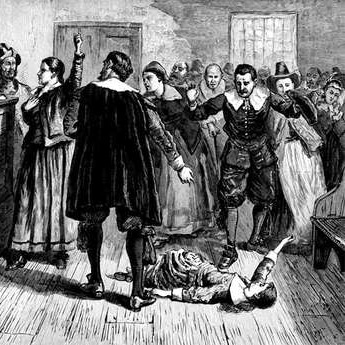 As most Americans know, witch hunts also affected the American colonies. The Salem witch trials pursued the Massachusetts Puritans have entered American consciousness as being much more then just the killing of witches. They, like the trials of Europe, have become a symbol. In our case, the witch trials have become a symbol of what can go wrong when mobs of ignorant people go crazy, especially when egged on by just as ignorant and/or power hungry leaders.
As most Americans know, witch hunts also affected the American colonies. The Salem witch trials pursued the Massachusetts Puritans have entered American consciousness as being much more then just the killing of witches. They, like the trials of Europe, have become a symbol. In our case, the witch trials have become a symbol of what can go wrong when mobs of ignorant people go crazy, especially when egged on by just as ignorant and/or power hungry leaders.
The Salem story began in 1692 when a few girls, who had become friendly with a slave woman named Tituba, began acting very strangely -- hysterical screaming, falling into convulsions, barking like dogs, etc. Soon other girls began acting in a similar manner and of course they all must have been possessed by demons. Three woman, including Tituba, were promptly accused of witchcraft. The result was much like the European experience, with a chain-reaction of confessions, denouncements, and more arrests.
In an effort to help combat the witch menace, courts relaxed traditional rules of evidence and procedure -- after all, witches are a terrible menace and must be stopped. In place of the normal rules and methods, the courts used what was common among Inquisitors in Europe -- scouring the womens' bodies for marks, numb spots, etc. Also accepted were "spectral sources" of evidence -- if someone had a vision of a woman being a witch, that was good enough for the judges.
The people who were mostly killed were not those who submitted quickly and obediently to authorities. Only those who were defiant or hostile were put to death. If you admitted being a witch and repented, you had a very good chance of living. If you denied being a witch and insisted that you had rights which must be acknowledged, you were on a quick path to execution. Your chances were also bad if you were a woman -- especially if you were an older, deviant, troublesome or somehow disorderly woman.
In the end, nineteen people were executed, two died in prison and one man was pressed to death under rocks. This is a better record than what we see in Europe, but that isn't saying very much. The religious and political authorities clearly used the witch trials to impose their own ideas of order and righteousness upon the local populace. As in Europe, violence was a tool used by religion and religious people to enforce uniformity and conformity in the face of dissent and social disorder.
Books You Might Enjoy:
Mira Ray - Minerals And Gems In Indian Alchemy
Anonymous - Protection Of Space
Gabor Klaniczay - Witchcraft Mythologies And Persecutions








